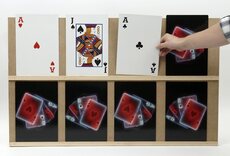Rules of Hoopla
Hoopla has been a well known attraction at fairs, fetes and fairgrounds for decades, if not centuries. Note: 1 foot ~= 30cm.
See also: Hoopla Game.
Preparation
Place the bases in a random pattern in front of the throwing line. Six or seven bases is a good number. The bases can be put on the floor but it's better to place them on a table. Distance from the throwing line or bar is typically only 4 or 5 feet. Place the prizes against the base poles - it's a good idea to secure the prizes to the pole with an elastic band. Select a variety of prizes so that the maximum number of people are attracted to the stall. Although it's fun in its own right, the better the prizes, the more people will want to have a go.
Rules
Normally, a nominal sum is charged for the chance to throw four hoops. As with most traditional fairground games, the standard rules mean that the game is much harder than it looks so that prizes are not won too often. In the case of Hoopla, the rules insist that the hoop comes to rest flat on the table around the Hoopla base - it's not good enough to just encircle the prize. For school fairs and in other situations where the intention is to give out many more prizes, we suggest relaxing the rules so that a prize is given any time the hoop encircles the prize even if it lands on top of the base.
Variations
To make it harder, increase the distance from the throwing line and / or reduce the number of hoops thrown per turn. To make it easier, decrease the throwing distance or increase the number of hoops per turn.
These rules are provided by Masters Traditional Games, an Internet shop selling quality traditional games, pub games and unusual games. For general information or for copying and copyright, see our Rules Information page.
Our rules are comprehensive instructions for friendly play. If in doubt, always abide by locally-played or house rules.
Copyright James Masters, 2025. All rights reserved.


























